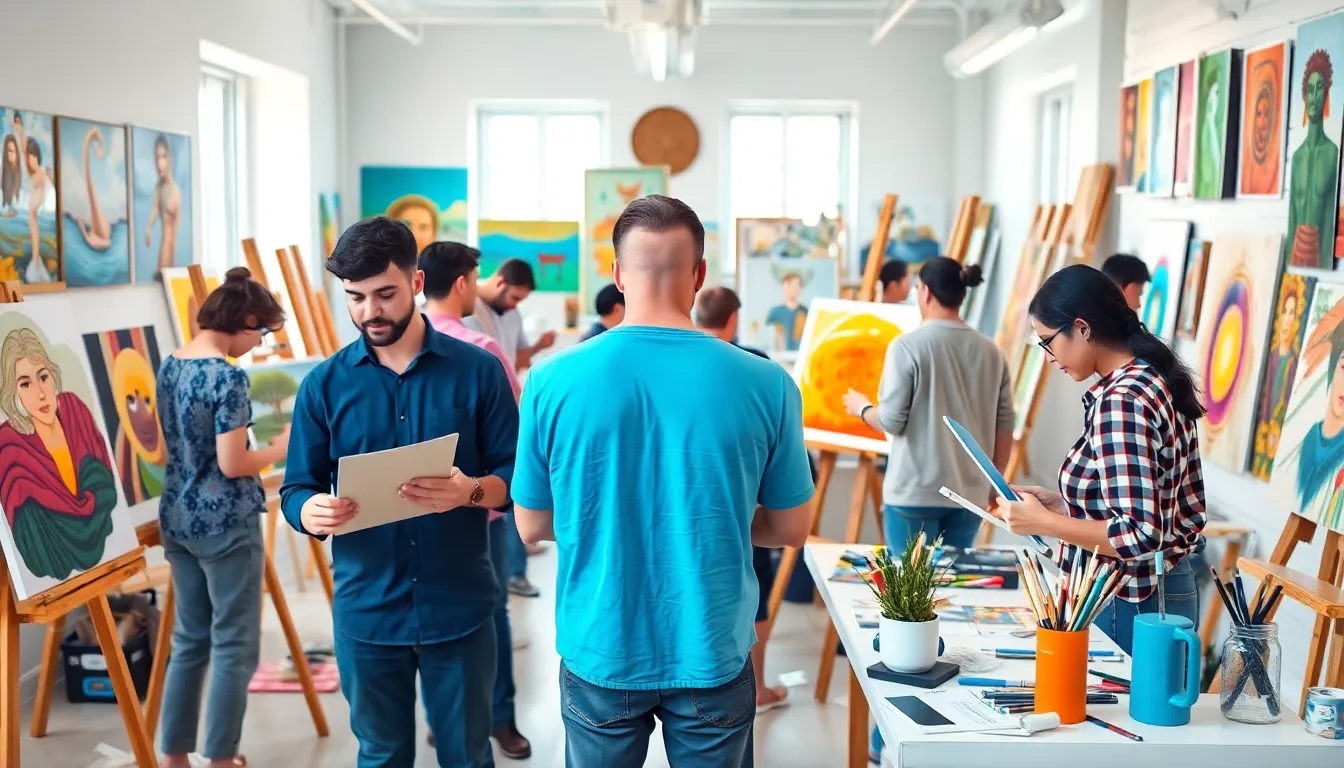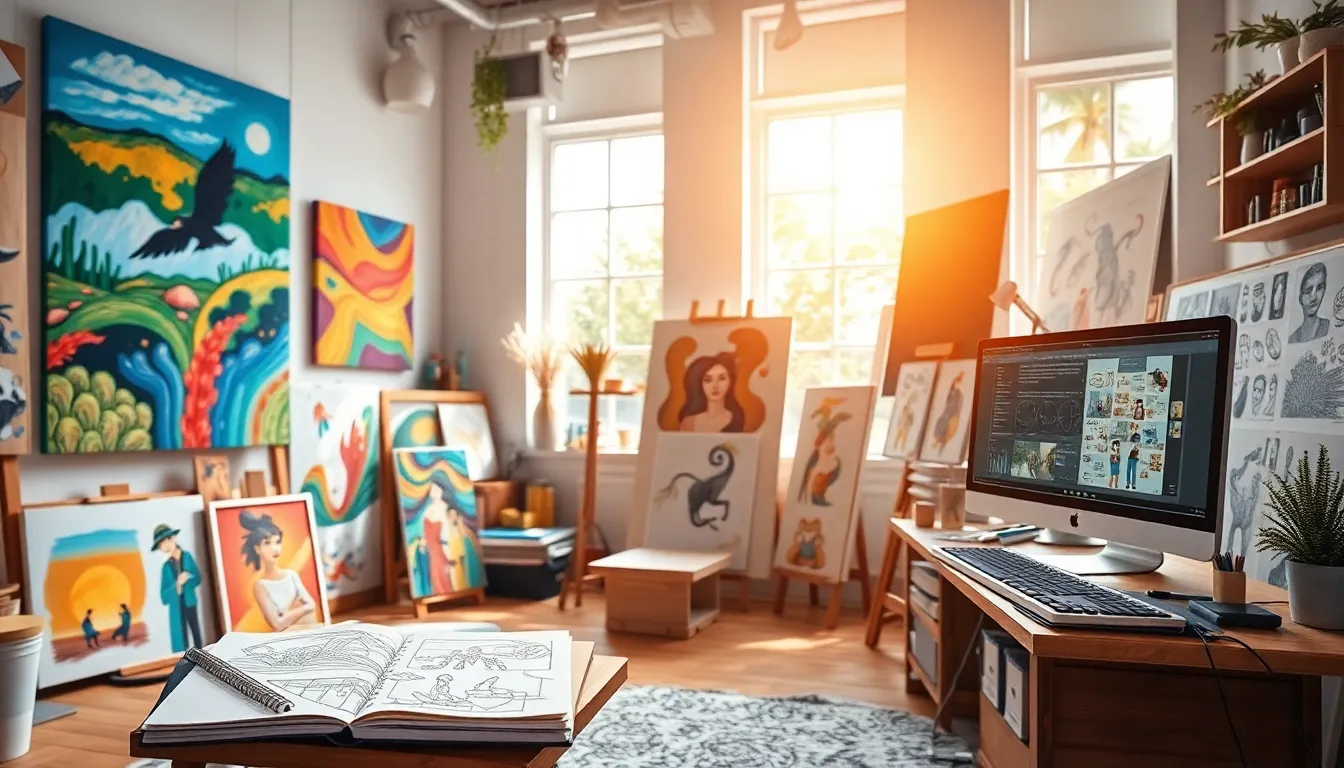In a world overflowing with information, creativity images stand out like a unicorn in a field of horses. They capture attention and spark inspiration, transforming mundane ideas into vibrant visuals that dance in the mind. Whether it’s a whimsical doodle or a breathtaking photograph, these images breathe life into concepts, making them irresistible.
Understanding Creativity Images
Creativity images have a unique ability to connect with viewers and convey complex ideas visually. These images play a vital role across various disciplines, making understanding them essential.
Definition of Creativity Images
Creativity images refer to visuals that express innovative ideas or emotions. These can include illustrations, digital art, and photography. Each creativity image aims to communicate a message or provoke thought through artistic expression. Such visuals often showcase imagination, merging aesthetics with concepts while inviting interpretation.
Importance in Various Fields
Creativity images hold significant importance across diverse fields. In marketing, they attract attention and enhance brand messaging. Education benefits by using creativity images to simplify concepts and engage students. Additionally, art relies on these visuals to evoke emotions and provoke discussions. Social media platforms thrive on creativity images, as they encourage sharing and connectivity among users. Each sector leverages creativity images to reinforce messages and foster deeper engagement.
Types of Creativity Images


Creativity images come in various forms, each offering unique ways to express innovative ideas and emotions. An exploration of these categories reveals the diverse landscape of visual creativity.
Visual Art and Illustration
Visual art and illustration serve as powerful mediums for storytelling. Artists use techniques ranging from painting to sketching, enabling them to convey complex ideas in tangible forms. Unique styles characterize diverse art movements, each contributing to the visual language. Illustrations can simplify challenging concepts, making them accessible to broader audiences. Heavily influenced by culture, these visual expressions resonate with viewers, often triggering emotional responses.
Photography and Digital Art
Photography captures real moments with striking clarity, often serving as a profound reflection of reality. Digital art expands this realm, allowing artists to manipulate images and create immersive experiences. Both mediums inspire through vibrant colors and compelling compositions. Photographic techniques, such as long exposure or macro shots, highlight details often overlooked in everyday life. Digital platforms enable collaboration, expanding artistic reach and inviting feedback, enhancing the creative process.
Graphic Design
Graphic design focuses on communication through visual elements such as typography, color, and layout. Designers blend these elements to create impactful visuals for branding and advertising. User experience holds significant importance in this field; effective design navigates viewers through information clearly. Innovative approaches to graphic design adapt to current trends while maintaining a brand’s identity. Infographics, logo designs, and advertising materials exemplify how graphic design shapes perceptions and interactions within various industries.
Techniques to Enhance Creativity Images
Creativity images benefit from various techniques that amplify their impact and reach. Understanding color theory and utilizing technology plays a significant role in this enhancement.
Color Theory and Composition
Color theory influences emotional responses and visual harmony. Warm colors like red and yellow generate excitement, while cool colors like blue and green evoke calmness. Using complementary colors creates contrast, drawing attention to key elements. Composition techniques, such as the rule of thirds, guide viewers’ focus through the image, improving overall engagement. Balancing negative space and active space also enhances clarity, allowing the message to resonate more effectively.
The Role of Technology
Technology significantly enhances creativity image production and distribution. Graphic design software, such as Adobe Creative Suite, provides tools for artists to apply advanced techniques and manipulate visuals. Digital photography allows for quick editing, enabling photographers to refine their work rapidly. Social media platforms create channels for sharing creativity images with wider audiences, fostering community and interaction. Using augmented reality and virtual reality in projects creates immersive experiences that captivate viewers, pushing the boundaries of traditional creative expression.
Applications of Creativity Images
Creativity images have wide-ranging applications across multiple fields, driving engagement and improving communication.
Marketing and Advertising
Creativity images play a crucial role in marketing and advertising strategies. They attract attention and convey brand messages effectively. Visuals evoke emotions, making campaigns memorable and impactful. For instance, high-quality graphics and engaging illustrations can simplify complex product information, allowing potential customers to grasp concepts quickly. Companies often utilize bright colors and unique designs to stand out in competitive markets. Engaging images also enhance social media campaigns, increasing shares and interactions. Ultimately, distinctive creativity images can significantly boost brand identity and recognition, creating lasting impressions on audiences.
Education and Learning Environments
In education, creativity images enhance learning experiences and foster engagement. Illustrations can simplify complex topics, making them more digestible for students. Teachers often use diagrams and infographics to illustrate theories and concepts, aiding comprehension. Visual aids also cater to diverse learning styles, accommodating visual learners who grasp information through imagery. Creative images promote collaboration in group projects, inspiring students to think outside conventional boundaries. Furthermore, incorporating creativity in educational materials sparks curiosity, motivating learners to explore topics deeply. As a result, creativity images transform learning environments, fostering a dynamic and interactive classroom atmosphere.

